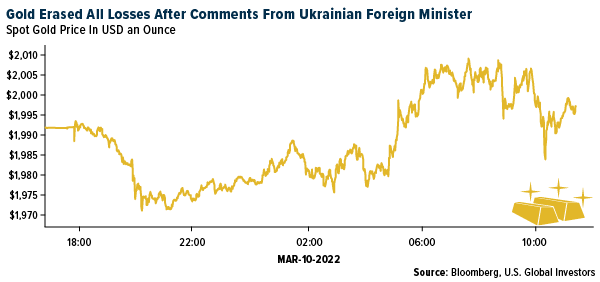Strengths
- The best performing precious metal for the week was silver, up 1.36% on the good gold tape. Gold climbed to a 19-month high above $2,000 an ounce amid mounting concerns over inflation and continued geopolitical tension between Russia and Ukraine. Bullion had earlier extended its biggest decline in 14 months, reports Bloomberg, on hopes that talks between the countries’ foreign ministers could lead to a solution. However, as talks failed to make progress, gold erased those losses.

- The London Bullion Market Association said on Monday it was removing all six Russian gold and silver refineries from its good delivery list. This amounted to a de facto ban on new bars from Russia being traded in the London market.
- Russia’s central bank is unlikely to sell its gold holdings to support a drop in the ruble amid sanctions, reports Goldman Sachs. The difficulty involved with liquidating gold reserves and the presence of a large current account surplus means Russia will focus on capital account restrictions to manage the ruble exchange rate. Historically, capital restrictions are a more effective tool at managing a tumbling currency than gold sales.
- The worst performing precious metal as we close out the week was palladium, down 6.30%. Palladium surged to an all-time high on mounting concerns that exports from top producer Russia could be disrupted by sanctions. Prices are so high, in fact, that thefts of the parts that use the metal in cleaner automobiles (catalytic converters), have risen sharply in the U.S. and elsewhere, reports Bloomberg. The metal did slide back as much as about 9% mid-week, however, after reaching its high price.
- Sibanye-Stillwater said the biggest unions at its gold mines gave notice that their workers will go on strike from Wednesday after talks over a new wage deal failed, reports Bloomberg. The strike threat comes as the South African company faces soaring costs at some of the world’s deepest and oldest gold mines. Sibanye’s three gold mines employ over 30,000 workers, the article continues.
- Royal Bafokeng Platinum reported disappointing fiscal year 2021 results as highlighted in the company’s trading statement. Its fiscal year 2021 underlying EBITDA missed consensus by 23% due to a combination of lower-than-forecast production volumes and revenue realizations, and higher-than-forecast unit costs, (with fiscal year 2021 EBITDA margins seven points lower than consensus).
Opportunities
- JPMorgan recommends increasing exposure to gold. Last week saw the highest inflation in commodity prices in 60 years (up 12% last week). Inflation risks are also severe due to the immediate supply shock to Russian commodity exports, along with the unfolding impact to downstream supply chains. JPMorgan believes extreme geopolitical risks could extend dovish monetary policy and the duration of negative real yields. Against this backdrop, there are clear macro tailwinds for South African-listed gold producers, which collectively trade at discounted equity multiples to their global gold peers.
- Shares in mining companies could outperform over the next three years as a result of consensus earnings upgrades and a re-rating of equity valuations, Jefferies says. Underinvestment in new mine capacity, combined with decarbonization-driven demand and cyclical consumption growth, should lead to tighter markets and higher prices for some key commodities between now and 2025, the U.S. bank says.
- According to Goldman Sachs, the recent rally across commodities and rising global geopolitical uncertainty means that its upside scenario on gold investment and central bank demand is now becoming the base case. At the same time, gold consumer demand continues to accelerate, driven primarily by buyers in Asia. The group now expects all three major components of gold demand to increase strongly in 2022. The last time Goldman saw all major demand drivers accelerate simultaneously was in 2010-2011 when gold rallied by almost 70%.
Threats
- The London Platinum and Palladium Market has decided not to revoke the accreditation of Russian refineries, allowing them to continue supplying precious metals to the trading hub. Following a meeting of the management committee, no changes will be made to its good delivery list, according to a spokesperson. There are currently two Russian refineries with accreditation to mint platinum and palladium for the London market.
- Kinross Gold announced that it is suspending Russian operations. The company’s Kupol mine was expected to produce 35,000 ounces which represents about 13% of total production. This week, in response to foreign companies exiting Russia, the government announced a plan whereby they would transfer the assets to external managers to preserve property and employees.
- Russia’s invasion of Ukraine could further shift investment from palladium to platinum if Russian supplies remain off the market. South Africa is one of the few countries that would benefit near term from the shift in markets.

